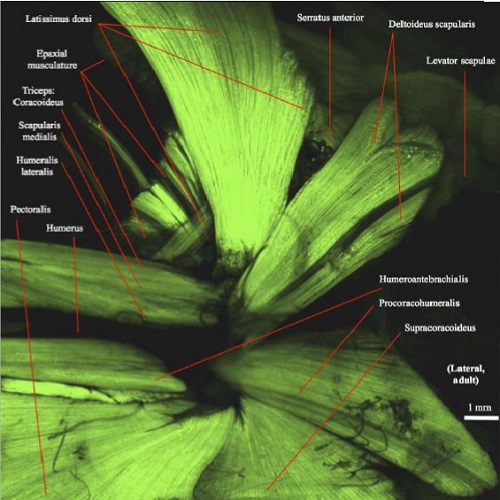Development of fore- and hindlimb muscles in GFP-transgenic axolotls: morphogenesis, the tetrapod bauplan, and new insights on the forelimb-hindlimb enigma.
The axolotl is becoming one of the most used model organisms in developmental and regenerative studies but no publication has described in detail the development of its forelimb and hindlimb muscles. We describe and illustrate the ontogeny of these muscles in transgenic axolotls that express GFP in muscle fibers and discuss our results and data previously obtained by us and by other authors about limb regeneration in axolotls and ontogeny in frogs and other tetrapods. Our observations and comparisons: (1) demonstrate radio-ulnar and ventro-dorsal morphogenetic gradients in the order of axolotl forelimb muscle formation and differentiation, while in axolotl hindlimb ontogeny there are only proximo-distal and tibio-fibular gradients; some of the axolotl gradients are therefore different from the ulno-radial/fibulo-tibial fore- and hindlimb and the dorso-ventral hindimb ontogenetic morphogenetic gradients seen in frogs and amniotes such as chickens; (2) provide a potential explanation for the usual presence, in both limbs of taxa from all major tetrapod groups, of more radial/tibial muscles than ulnar/fibular muscles; (3) support the "in-out" developmental mechanism of appendicular muscle formation; (4) offer new insights about the ancestral Bauplan of tetrapod limbs, including the striking similarity of the zeugopodial (forearm/leg) and autopodial (hand/foot) muscles of the two limbs and the ventro-dorsal symmetry of the zeugopodial muscles of a same limb; and (5) provide further evidence to corroborate the hypothesis that these similarities are due to derived homoplastic events that occurred during the fins-limbs transition and not due to forelimb-hindlimb serial homology.

- J. Exp. Zool. B Mol. Dev. Evol. 2014 Feb 03;322(2):106-27
- 2014
- Developmental Biology
- 24302552
- PubMed
Enabled by:
